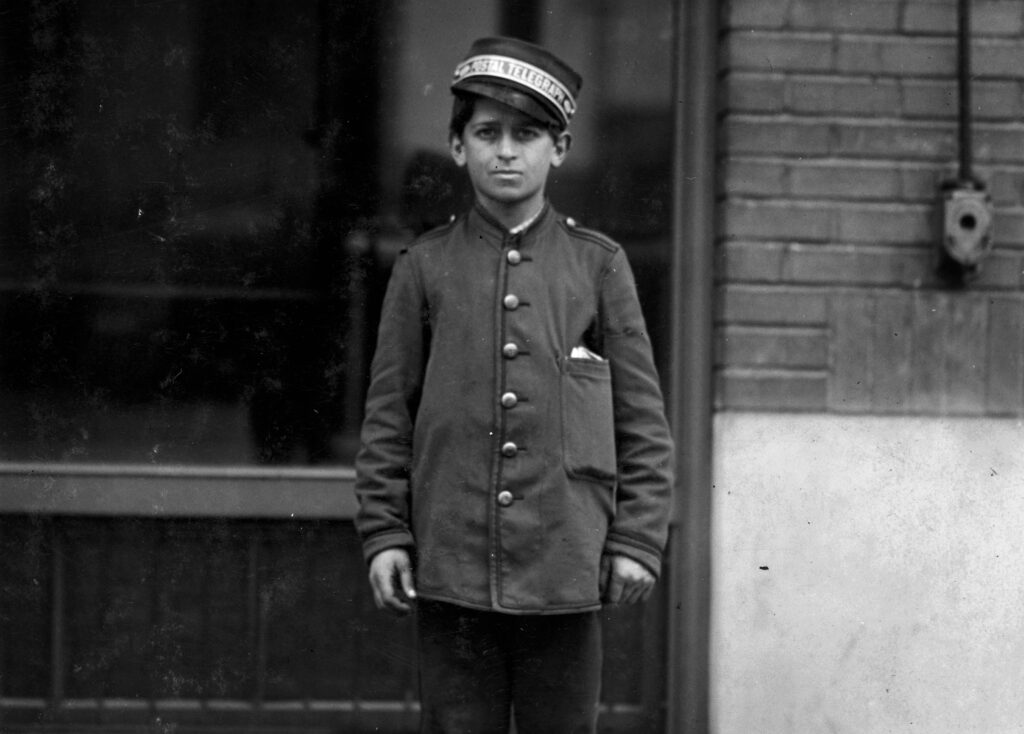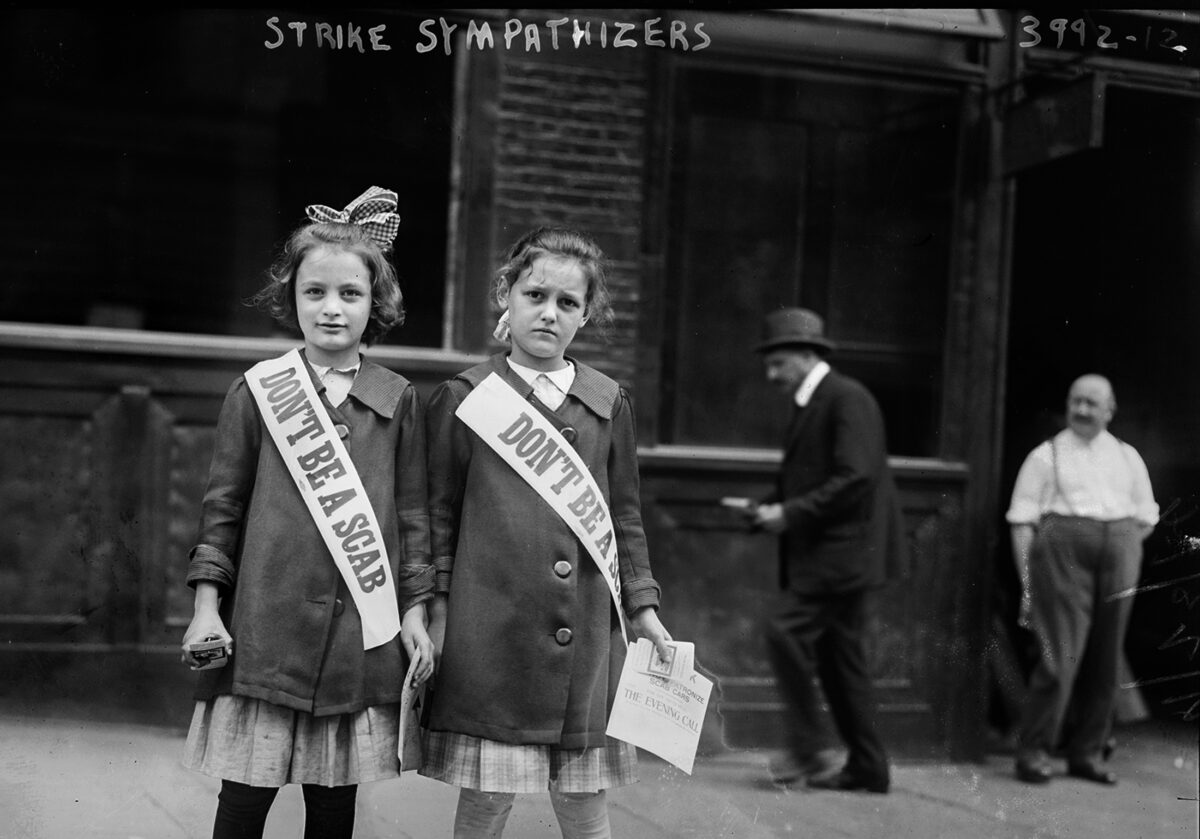The first person quoted in a Pittsburgh newspaper using the word “scab” to describe strikebreaking workers was a boy standing on a Downtown Pittsburgh street corner in 1881. He wore the uniform of his profession: a dark blue suit with white piping on the trousers, a jacket with brass buttons and a billed cap.
The boy was a telegraph messenger, one of 40 who worked from 7 a.m. to 6 p.m. each day to deliver wire dispatches. In the late 1800s, they were a common sight, darting through the city’s dusty streets, leaping over horse dung, sometimes hopping in the back of a cart heading their way (an offense for which they were fined 25 cents if caught by “watchers” hired by their employers). They worked two nights each week and every third Sunday, their schedules so tight they rarely had time for dinner.
By fall of 1881, a consolidation of telegraph companies had increased the messenger boys’ workload — now they were delivering dispatches for both companies, in addition to running errands and carrying packages for businessmen. It was simply too much.
So the boys, ranging in age from 10 to 18, demanded better wages and working conditions. After the bosses said no, the workers called a strike. On the evening of Sept. 10 they walked out, and by 7 o’clock the intersection of Fifth Avenue and Wood Street, location of the city’s telegraph offices, had become the epicenter of a unique labor dispute.
Curious businessmen jammed the sidewalks. Police officers cleared the way while keeping their eyes on messenger boys clustered in groups and chatting among themselves. A reporter for the Pittsburgh Commercial Gazette pulled aside one of the strikers, a “little fellow who was hardly over ten years of age.”
The reporter asked, “Are all of your colleagues on strike?”
“No sir, most of us quit work at six o’clock,” the boy replied, “but Nos. 6, 34, 19 and 15 are ‘scabs.’ I tell you, it is mean of them, too.”
We can assume by the boy’s comment that the child workers were identified by number instead of by name.
At one point, a boy who refused to join the strike emerged from a telegraph office with a delivery. The strikers spotted him. The messenger boy bolted. “There he goes,” yelled a striker. He and several of his colleagues took off in pursuit, followed by several burly policemen.

Since that evening, Pittsburgh newspapers have regularly used the word “scab” to describe strikebreakers. A search on newspapers.com reveals thousands of results. In the past several decades, “scab” has most often been used in quotes by union officials or strikers.
But not always. In 1984, a Pittsburgh Press headline read, “Several scabs remain, but strike wounds from ’79 healing.” The story concerned the lingering effects of a Major League umpires walkout years earlier.
As recently as 2008, the Post-Gazette used the word to describe writers providing copy for daytime soap operas in the midst of a writers strike. While a strike loomed at Slippery Rock University in 2016, professors debated whether the word “scab” was too jarring to hurl at strikebreaking colleagues.
The educators’ concern was embedded in an understanding that the word “scab” is viewed as many things: an epithet, an accusation of moral and ethical failure (whether it’s an unfair accusation depends on which side of the picket line one occupies), an efficient and widely understood term describing someone who crosses a picket line.
This is certain: Few words have been flung with such anger, or received with such anxiety. That’s increasingly been the case in Pittsburgh since the October 2022 beginning of a strike by Post-Gazette production and newsroom workers.
At the Post-Gazette’s South Side distribution facility, strikebreaking delivery drivers are pelted with the word “scab” as they speed their vehicles past knots of striking workers. On social media, those who’ve crossed the PG picket lines have been tagged as scabs by their striking colleagues as well as an array of Twitter posters with handles such as punk-o-demic, Hmmmmmm and The Official Grocery Store Parent, as well as journalists such as BuzzFeedNews tech reporter Katie Notopoulos, who boasts 85,000 followers, and Kaley Johnson of the Fort Worth Star-Telegram.
It makes you wonder: Where did the word originate, and how did it become so loaded?
In her 2006 book “Household Words,” which examines the histories and uses of six controversial terms used as politically edged insults, Stephanie A. Smith dates the word “scab” to 1250. Its meaning then was singular. A scab was a crust or blemish on the skin, usually associated with disease like leprosy, scabies and mange.
By 1590, the book notes, “scab” had picked up another meaning: slang for a scoundrel or cheat. The word made its first official appearance in the United States as a term describing strikebreakers during an 1806 trial of striking bootmakers and shoemakers.
Smith notes that, although the word’s meaning has morphed from the physical to the moral register, it continues to reflect the idea of a physical blemish — as metaphor.
“Just as a scab is a physical lesion, the strike-breaking scab disfigures the social body of labor — both the solidarity of workers and the dignity of work,” she wrote.
The word reached its apex of brutality in 1915, the year author Jack London penned his brutal “Ode to a Scab.” In 200 words, London denounces the scab for having a “tumor of rotten principles” in place of a heart and touches on both patriotic and Christian themes, describing strikebreakers as lower than Benedict Arnold and Judas Iscariot, unwanted even at the gates of hell.
Since then, the word “scab” has lost some of its sting. As corporations gain power, squeezing employees for more productivity at the least cost, workers lose influence and control over their workplaces and therefore become more vulnerable. Their main concern is keeping their jobs.
“Most workers in the United States today are content to either perform or to endure scab labor, so long as they continue working,” Smith wrote.
The word’s sting in Pittsburgh seems to have fluctuated in the past 140 years.
During a labor dispute at the Homestead Works steel mill in 1883, editors of the Pittsburgh Daily Post used the word “scab,” though they did so most tenderly. The article notes that strikebreakers are “designated ‘scabs’ by union men and which name we adopt simply to distinguish them from the ‘strikers.’”
Within a decade, the word had picked up steam. In the midst of an 1892 trolley workers strike against the Pittsburgh, Allegheny and Manchester Traction Co., a reporter for the Pittsburgh Sun Dispatch rode a car as it crossed the Allegheny River.
“Just as soon as the Allegheny side of the Sixth Street bridge was reached, a crowd commenced gathering, and from that time until the car barn was reached nothing could be heard but ‘scab’ in all the various tones of voice of young and old humanity,” the article reads. “It seemed as if the city had emptied its houses to show sympathy for the striking employees and that men, women and children were vying with each other to see which could make the most noise.”
But by 1928, PG reporter Ray Sprigle learned that, in at least one labor dispute, the word’s power had changed. In March of that year, Sprigle embarked on one of his undercover gigs, this time as a strikebreaking coal miner in the Coverdale No. 8 mine in Bethel Park.
Sprigle and several other scab miners climbed into the bed of a covered truck in Downtown Pittsburgh and departed for the mine. After passing through the Liberty Tubes, the truck headed into Dormont, where a group of schoolboys spied the miners riding in the bed. Sprigle noted the reaction: “For the first time we heard the yell of ‘scab.’”
Next, the truck rumbled through Mt. Lebanon, passing a “group of well-dressed little girls,” one of whom cupped her hands around her mouth and sent the miners on their way with “a ringing of ‘scab, scab.’”
Upon reaching Bethel Park, the truck sped past barracks of striking miners evicted from the company houses and groups of union men shouting, “Keep away, men, keep away, strike on.” They finally arrived at Coverdale. “At last we were ‘scabbin’ in number eight.”
Sprigle spent a week with the miners. He found they weren’t particularly bothered by those calling them scabs. In fact, they embraced the term.
“They refer to themselves as scabs,” Sprigle wrote. “Their camp is a ‘scab camp.’ Their greeting to a newly found ‘buddy’ is not ‘How long have you been working here?’ but ‘How long have you been scabbin’?’”
One image from the week lingered in Sprigle’s memory. As the scab miners approached Coverdale they saw, standing on a knoll, a figure.
“It was a woman, tall and powerful,” Sprigle wrote. Her face was “a mask of tragedy, seamed and lined.” A child clutched her skirt.
As the truck passed, the woman struck a gesture that seemed to Sprigle a dramatic symbol of the strikers’ determination: She thrust her clenched first upward.
A companion offered Sprigle a thought. “They fight until they starve,” he said. “And I think when they all starved, they gonna fight anyway.”
Steve is a photojournalist and writer for the Pittsburgh Post-Gazette, but he is currently on strike and working as a Union Progress co-editor. Reach him at smellon@unionprogress.com.



